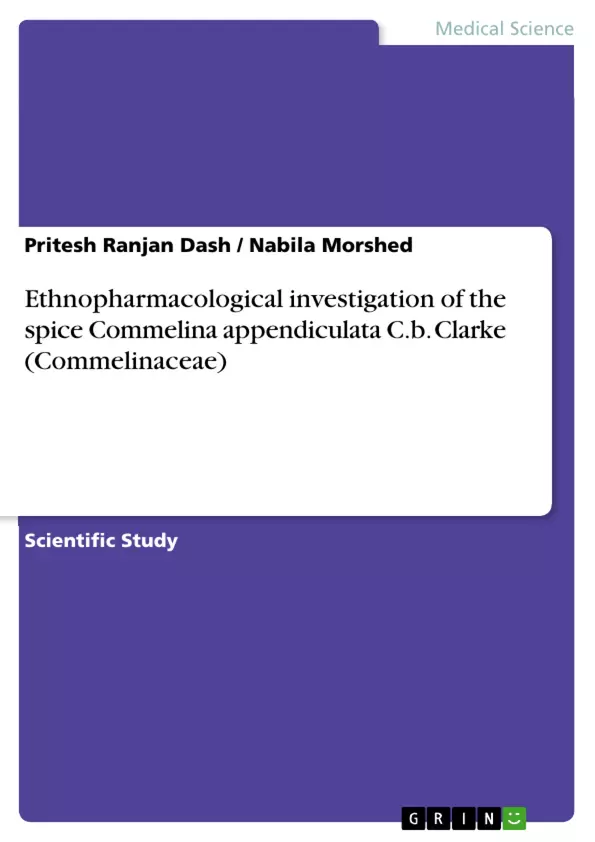In this ethnopharmacological study, the ethanolic extract of Commelina appendiculata (EECA) was subjected to pharmacological activity test. Phytochemical study revealed the presence of carbohydrates, tannins, flavonoids, glycosides and alkaloids in the ethanolic extract of Commelina appendiculata. In Swiss albino mice, analgesic, cns depressant and antidiarrhoeal activity were investigated. The extract was also evaluated for cytototoxic activity.
Inhaltsverzeichnis (Table of Contents)
- Abstract
- CHAPTER-1: INTRODUCTION
- General introduction
- Medicinal plants
- Introduction to commelinaceae family
- Aim of the present study
- Present study protocol
- CHAPTER-2: MATERIALS AND METHODS
- Plant material
- Biological investigations of Commelina appendiculata
- Analgesic activity test
- Acetic acid induced writhing method
- Hot plate method
- Tail immersion method
- Neuropharmacological activity test
- Thiopental sodium induced sleeping time method
- Hole cross method
- Open field method
- Anti-diarrhoeal activity test
- Castor oil induced diarrhoea method
- Magnesium Sulphate-Induced Diarrhea
- Cytotoxic activity test
- Brine shrimp lethality bioassay
- Analgesic activity test
- Phytochemical investigations of Commelina appendiculata
- Preparation of reagents used for different chemical group tests
- Test procedure for identifying different chemical groups
- CHAPTER-3: RESULTS AND DISCUSSIONS
- Biological investigations
- Analgesic activity
- Acetic acid induced writhing method
- Hot plate method
- Tail immersion method
- Discussion
- Neuropharmacological activity
- Thiopental sodium induced sleeping time method
- Hole cross method
- Open field method
- Discussion
- Anti-diarrhoeal activity
- Castor oil induced diarrhoea method
- Magnesium Sulphate-Induced Diarrhea
- Discussion
- Cytotoxic activity
- Brine shrimp lethality bioassay
- Discussion
- Analgesic activity
- Phytochemical screening
- Discussion
- Conclusion
- Biological investigations
Zielsetzung und Themenschwerpunkte (Objectives and Key Themes)
This study aims to investigate the potential pharmacological properties of an ethanol extract of Commelina appendiculata (EECA), focusing on its analgesic, central nervous system (CNS) depressant, antidiarrheal, and cytotoxic activities. The study explores the efficacy of EECA in alleviating pain, influencing CNS activity, and combating diarrhea. Additionally, it investigates the cytotoxic potential of the extract.
- Analgesic activity of EECA
- CNS depressant activity of EECA
- Antidiarrheal activity of EECA
- Cytotoxic activity of EECA
- Phytochemical analysis of EECA
Zusammenfassung der Kapitel (Chapter Summaries)
- CHAPTER-1: INTRODUCTION: This chapter provides an overview of the historical and contemporary importance of medicinal plants in healthcare. It introduces the Commelinaceae family and highlights the specific aim and methodology of the study focused on Commelina appendiculata.
- CHAPTER-2: MATERIALS AND METHODS: This chapter details the materials and methods used in the study, including the plant material preparation, various biological investigations (analgesic, neuropharmacological, anti-diarrhoeal, cytotoxic), and phytochemical analysis techniques.
- CHAPTER-3: RESULTS AND DISCUSSIONS: This chapter presents the findings of the biological and phytochemical investigations. It analyses the analgesic, CNS depressant, antidiarrheal, and cytotoxic activities of the EECA and discusses the implications of these findings.
Schlüsselwörter (Keywords)
The primary focus of this research is on the ethnopharmacological investigation of Commelina appendiculata. The study explores its potential as a source of natural remedies, particularly in the areas of analgesia, CNS modulation, antidiarrheal action, and cytotoxicity. Key concepts include analgesic activity, CNS depressant activity, antidiarrhoeal activity, cytotoxic activity, phytochemical screening, and traditional medicine practices.
- Arbeit zitieren
- Pritesh Ranjan Dash (Autor:in), Nabila Morshed (Autor:in), 2012, Ethnopharmacological investigation of the spice Commelina appendiculata C.b. Clarke (Commelinaceae), München, GRIN Verlag, https://www.grin.com/document/383259



